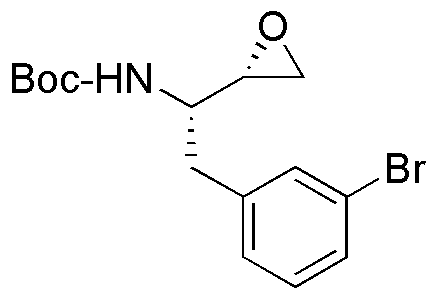erythro-N-Boc-L-3-bromophenylalanine epoxide is widely utilized in research focused on:
- Drug Development: This compound serves as a valuable intermediate in synthesizing pharmaceuticals, particularly in the development of novel therapeutic agents targeting various diseases.
- Biochemical Research: It is used in studies investigating protein interactions and enzyme mechanisms, helping researchers understand biological processes at a molecular level.
- Peptide Synthesis: The compound plays a crucial role in the synthesis of peptides, which are essential for creating biologically active molecules and drug candidates.
- Material Science: It can be incorporated into polymer systems, enhancing material properties for applications in coatings and adhesives.
- Diagnostics: The compound is explored for its potential use in diagnostic applications, particularly in developing biosensors that detect specific biomolecules.
General Information
Properties
Safety and Regulations
Applications
erythro-N-Boc-L-3-bromophenylalanine epoxide is widely utilized in research focused on:
- Drug Development: This compound serves as a valuable intermediate in synthesizing pharmaceuticals, particularly in the development of novel therapeutic agents targeting various diseases.
- Biochemical Research: It is used in studies investigating protein interactions and enzyme mechanisms, helping researchers understand biological processes at a molecular level.
- Peptide Synthesis: The compound plays a crucial role in the synthesis of peptides, which are essential for creating biologically active molecules and drug candidates.
- Material Science: It can be incorporated into polymer systems, enhancing material properties for applications in coatings and adhesives.
- Diagnostics: The compound is explored for its potential use in diagnostic applications, particularly in developing biosensors that detect specific biomolecules.
Documents
Safety Data Sheets (SDS)
The SDS provides comprehensive safety information on handling, storage, and disposal of the product.
Product Specification (PS)
The PS provides a comprehensive breakdown of the product’s properties, including chemical composition, physical state, purity, and storage requirements. It also details acceptable quality ranges and the product's intended applications.
Certificates of Analysis (COA)
Search for Certificates of Analysis (COA) by entering the products Lot Number. Lot and Batch Numbers can be found on a product’s label following the words ‘Lot’ or ‘Batch’.
Numéro de catalogue
Numéro de lot/série
Certificates Of Origin (COO)
This COO confirms the country where the product was manufactured, and also details the materials and components used in it and whether it is derived from natural, synthetic, or other specific sources. This certificate may be required for customs, trade, and regulatory compliance.
Numéro de catalogue
Numéro de lot/série
Safety Data Sheets (SDS)
The SDS provides comprehensive safety information on handling, storage, and disposal of the product.
DownloadProduct Specification (PS)
The PS provides a comprehensive breakdown of the product’s properties, including chemical composition, physical state, purity, and storage requirements. It also details acceptable quality ranges and the product's intended applications.
DownloadCertificates of Analysis (COA)
Search for Certificates of Analysis (COA) by entering the products Lot Number. Lot and Batch Numbers can be found on a product’s label following the words ‘Lot’ or ‘Batch’.
Numéro de catalogue
Numéro de lot/série
Certificates Of Origin (COO)
This COO confirms the country where the product was manufactured, and also details the materials and components used in it and whether it is derived from natural, synthetic, or other specific sources. This certificate may be required for customs, trade, and regulatory compliance.


